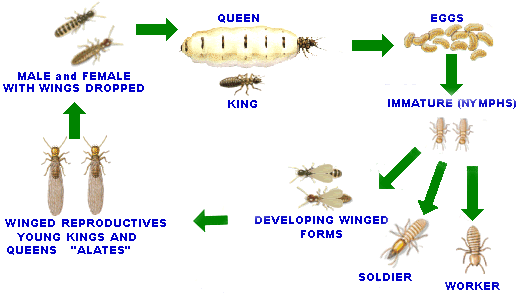It is essential for your termite control professional to properly identify the species of termite found in your property. Some species of termites found in trees, for example, will not attack dry seasoned timbers in a building, whilst others can be are highly destructive to such buildings in a short amount of time.
 Coptotermes acinaciformis Coptotermes acinaciformis
Commonly found throughout Victoria - particularly in urban areas or where eucalypt gum trees are highly prevalent.
Nest Location - Coptotermes acinaciformis are a very secretive termite species; they build their nest out of sight, often within the base of eucalyptus or other susceptible trees, or completely under the ground; often within an enclosed patio or under concrete (on ground) flooring which is ideal for moisture retention, temperature and humidity control within the termite colony nest. This species often build subsidiary nests away from the main colony nest. A subsidiary nest can be contained in a wall cavity of a building where there is a reliable moisture source, for example, from a leaking shower recess or faulty guttering or rusted down pipes.
Destructive Nature - Coptotermes acinaciformis are highly destructive to buildings and other timber structures. They are the most widely distributed and destructive timber pest in Australia, accounting for more than 70% of the serious damage to buildings in Victoria. A single colony may consist of more than one million termites. A most voracious timber pest ... one to be taken seriously.
 Coptotermes frenchi Coptotermes frenchi
Commonly found throughout Victoria; the most prevalent destructive termite species in the Gippsland and other regions where eucalypt gum trees are present. They are highly active in Melbourne and other urban areas in Victoria, where buildings are constructed of softwood or oregon timber framing.
Nest Location - Coptotermes frenchi most often build their nest in the root crown or lower trunk area of living trees, particularly eucalypts. They may also build their nest as a mound in the dryer areas of Victoria.
Destructive Nature - Coptotermes frenchi can cause severe damage to buildings and other wooden structures. It is common for this species to devour timber framing leaving only a thin veneer. This species is the most shy of the destructive species; they will retreat from a location immediately (for the time being) if disturbed. Requires expert knowledge and a sensitive touch to gain effective control.
 Nasutitermes exitiosus Nasutitermes exitiosus
Commonly found throughout Victoria - particularly in urban areas or where eucalypt gum trees are highly prevalent.
Nest Location - Nasutitermes exitiosus build a mound nest which protrudes 30cm to 75cm above the ground. Control can be as easy as knocking the top off the nest and a follow up insecticide treatment inside the nest.
Destructive Nature - Nasutitermes exitiosus are destructive to buildings and other timber structures. Sometimes severe damage may occur, but not so commonly as the other species listed above.
 Coptotermes lacteus Coptotermes lacteus
Commonly found in eastern Victoria - particularly prevalent in Melbourne, Gippsland and
Albury-Wodonga regions.
Nest Location - this termite species, most often builds it's nest as a mound up to 2m above ground level, with hard clay walls, so control is easily effected once located by knocking the top off and insecticide treatment of the nest.
Destructive Nature - Coptotermes lacteus attacks stumps, dead trees, timber fences, poles and other timber structures that are in contact with the soil, being softened by weathering or decay. These termites are also known to attack such timber in damp sub-floor areas.
 Heterotermes ferox Heterotermes ferox
Commonly found throughout Victoria - particularly in urban areas or where eucalypt gum trees are highly prevalent.
Nest Location - Heterotermes ferox often build their colony nest next to stumps, logs, or other timber in direct contact with the soil where some wood decay or rotting is prevalent.
Destructive Nature - Heterotermes ferox are be destructive to damp timbers and are usually found attacking fences, poles and other timber structures subject to wood decay from weathering or from being in contact with the soil. This species is often confused with the more aggressive and destructive Coptotermes acinaciformis species. Correct identification is essential.
 Dampwood termites - form small independent nests which often attack sick or dead trees, decaying stumps or mouldy timber in the ground; they are seldom found in dry timbers in buildings. Dampwood termites - form small independent nests which often attack sick or dead trees, decaying stumps or mouldy timber in the ground; they are seldom found in dry timbers in buildings.
|
